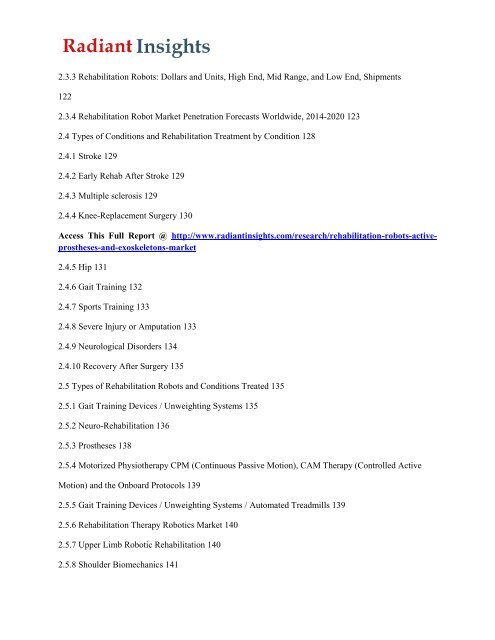Rehabilitation Robots Market Share, Size, Growth, Trend and Forecasts Report 2015 to 2021: Radiant Insights, Inc
WinterGreen Research announces that it has published a new study Rehabilitation Robots: Market Shares, Strategy, and Forecasts, Worldwide, 2014 to 2020. The 2015 study has 659 pages, 266 tables and figures. Worldwide markets are poised to achieve significant growth as the rehabilitation robots, active prostheses, and exoskeletons are used inside rehabilitation treatment centers and sports facilities providing rehabilitation for all patients with injuries or physical dysfunction. Access This Full Report @ http://www.radiantinsights.com/research/rehabilitation-robots-active-prostheses-and-exoskeletons-market Relearning of lost functions in a patient depends on stimulation of desire to conquer the disability. The rehabilitation robots can show patients progress and keep the progress occurring, encouraging patients to work on getting healthier. Independent functioning of patients depends on intensity of treatment, task-specific exercises, active initiation of movements and motivation and feedback. Rehabilitation robots can assist with these tasks in multiple ways. Creating a gaming aspect to the rehabilitation process has brought a significant improvement in systems. As patients get stronger and more coordinated, a therapist can program the robot to let them bear more weight and move more freely in different directions, walking, kicking a ball, or even lunging to the side to catch one. The robot can follow the patient’s lead as effortlessly as a ballroom dancer, its presence nearly undetectable until it senses the patient starting to drop and quickly stops a fall. In the later stages of physical therapy, the robot can nudge patients off balance to help them learn to recover.
WinterGreen Research announces that it has published a new study Rehabilitation Robots: Market Shares, Strategy, and Forecasts, Worldwide, 2014 to 2020. The 2015 study has 659 pages, 266 tables and figures. Worldwide markets are poised to achieve significant growth as the rehabilitation robots, active prostheses, and exoskeletons are used inside rehabilitation treatment centers and sports facilities providing rehabilitation for all patients with injuries or physical dysfunction.
Access This Full Report @ http://www.radiantinsights.com/research/rehabilitation-robots-active-prostheses-and-exoskeletons-market
Relearning of lost functions in a patient depends on stimulation of desire to conquer the disability. The rehabilitation robots can show patients progress and keep the progress occurring, encouraging patients to work on getting healthier. Independent functioning of patients depends on intensity of treatment, task-specific exercises, active initiation of movements and motivation and feedback. Rehabilitation robots can assist with these tasks in multiple ways. Creating a gaming aspect to the rehabilitation process has brought a significant improvement in systems.
As patients get stronger and more coordinated, a therapist can program the robot to let them bear more weight and move more freely in different directions, walking, kicking a ball, or even lunging to the side to catch one. The robot can follow the patient’s lead as effortlessly as a ballroom dancer, its presence nearly undetectable until it senses the patient starting to drop and quickly stops a fall. In the later stages of physical therapy, the robot can nudge patients off balance to help them learn to recover.
Create successful ePaper yourself
Turn your PDF publications into a flip-book with our unique Google optimized e-Paper software.
2.3.3 <strong>Rehabilitation</strong> <strong>Robots</strong>: Dollars <strong>and</strong> Units, High End, Mid Range, <strong>and</strong> Low End, Shipments<br />
122<br />
2.3.4 <strong>Rehabilitation</strong> Robot <strong>Market</strong> Penetration <strong>Forecasts</strong> Worldwide, 2014-2020 123<br />
2.4 Types of Conditions <strong>and</strong> <strong>Rehabilitation</strong> Treatment by Condition 128<br />
2.4.1 Stroke 129<br />
2.4.2 Early Rehab After Stroke 129<br />
2.4.3 Multiple sclerosis 129<br />
2.4.4 Knee-Replacement Surgery 130<br />
Access This Full <strong>Report</strong> @ http://www.radiantinsights.com/research/rehabilitation-robots-activeprostheses-<strong>and</strong>-exoskele<strong>to</strong>ns-market<br />
2.4.5 Hip 131<br />
2.4.6 Gait Training 132<br />
2.4.7 Sports Training 133<br />
2.4.8 Severe Injury or Amputation 133<br />
2.4.9 Neurological Disorders 134<br />
2.4.10 Recovery After Surgery 135<br />
2.5 Types of <strong>Rehabilitation</strong> <strong>Robots</strong> <strong>and</strong> Conditions Treated 135<br />
2.5.1 Gait Training Devices / Unweighting Systems 135<br />
2.5.2 Neuro-<strong>Rehabilitation</strong> 136<br />
2.5.3 Prostheses 138<br />
2.5.4 Mo<strong>to</strong>rized Physiotherapy CPM (Continuous Passive Motion), CAM Therapy (Controlled Active<br />
Motion) <strong>and</strong> the Onboard Pro<strong>to</strong>cols 139<br />
2.5.5 Gait Training Devices / Unweighting Systems / Au<strong>to</strong>mated Treadmills 139<br />
2.5.6 <strong>Rehabilitation</strong> Therapy Robotics <strong>Market</strong> 140<br />
2.5.7 Upper Limb Robotic <strong>Rehabilitation</strong> 140<br />
2.5.8 Shoulder Biomechanics 141


















